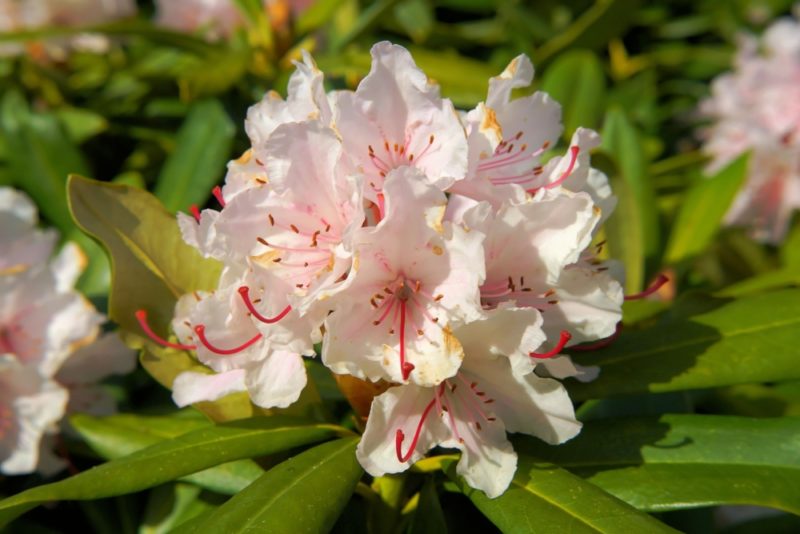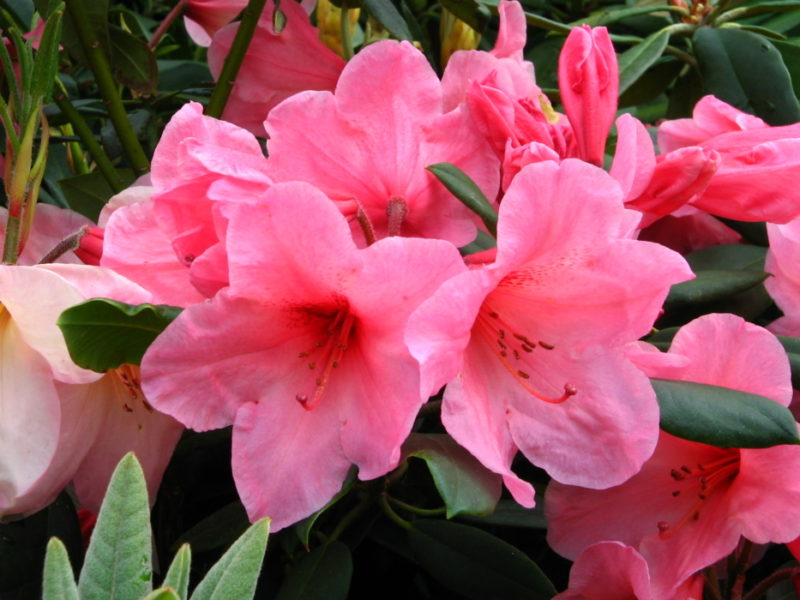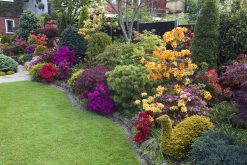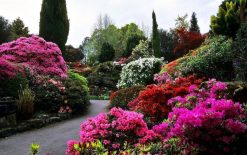Previously, the cultivation of these plants in open ground was not available for the northern regions: even if the bush could be maintained in winter, one could forget about flowering. Now the emergence of resistant varieties, the proper planting and care of rhododendrons in the Leningrad region make it possible to see beautiful flowering.
Material Content:
Description and features of rhododendron
These plants from the Heather family have become popular in decorative gardening due to their beautiful flowering. In nature, they are represented by different life forms - from large trees to dwarf shrubs. Rhododendrons grow in temperate and subtropical climates on all continents of the earth. Among them are evergreen and deciduous plants. On the territory of Russia 18 species of rhododendrons grow in the wild.
Leaves vary in size and shape, most often whole, sometimes serrate. Flowers are collected in lush inflorescences-shields, less often - single. Seeds ripen in a five-leaved box. In nature, rhododendrons grow on acidic moist, well-drained soils in the undergrowth. Many types of rhododendrons are poisonous: they contain neurotoxins that disrupt the human nervous system.
Frost resistant varieties
Work on the removal of frost-resistant evergreen rhododendrons was carried out by Finnish breeders in the 70s of the twentieth century.
Then the first 9 famous varieties were obtained:
- Helsinki University - lush bright pink inflorescences;
- Mikkeli - pink and white simple flowers;
- Pekka - pale pink flowers with wavy petals;
- Piter Tigerstedt - snow-white flowers with a burgundy mottled pattern on the upper petal;
- Haaga - bright pink, lush inflorescences;
- Hellikki - lilac red flowers;
- Kullervo - delicate pink and white inflorescences;
- Elviira - scarlet flowers;
- Pohjola’s Daughter - soft pink corollas with a yellow mottled pattern on the upper petal.
Later, other excellent varieties of Finnish breeding, resistant to harsh winters, appeared. In addition to evergreen rhododendrons, deciduous species have good frost resistance. It is worth paying attention to a series of varieties of Lights, created at the University of Minnesota.
Deciduous varieties of rhododendron for the Leningrad region:
- Orchid Lights - purple-pink flowers with yellow spots;
- Golden Lights - orange-yellow flowers with a light throat and pinkish edges of the petals;
- Mandarin Lights - reddish-orange flowers with wavy petals;
- Pink Lights - pale pink corollas with a yellow spot in the upper lobe;
- Rosy Lights - pink flowers.
The listed varieties withstand temperatures in winter of -37 ° C. During flowering, they smell good. There are other frost-resistant rhododendrons, for example, the group of varieties P.J.M. obtained by crossing the Daurian and Caroline rhododendrons. But these plants withstand frosts to -29 ° C. When buying in a nursery, you need to choose varieties that can withstand temperature drops to -35 ° C and below.
Growing requirements in the Leningrad region
To succeed, you need to choose the right landing site and know all the features of agricultural technology.
Rhododendrons prefer such growing conditions:
- acidic, breathable soil;
- moderate watering without stagnation of moisture and drying out of the soil;
- a slightly shaded place on the site where the bright sun will be at least 6 hours a day.
All flowering shrubs love the sun, so the planting site should be well-lit part of the day. But the midday sun does not like rhododendrons: flowers quickly fade, the flowering time is reduced. Light penumbra is better suited. Adult shrubs successfully cope with a lack of sun.
Rules and terms of planting in open ground
Saplings bought in the nursery or grown independently are planted in open ground in May, when the threat of return frosts passes. When transplanting, an earthen lump around the roots is not destroyed, and the root neck is not buried. The rest of the complexity comes down to the proper preparation of the land.
Rhododendrons need acid soil to plant. You can not plant plants in peat soil, it dries quickly and is not nutritious enough. It is necessary to mix fertile soil with acid peat and coniferous litter, fill the hole with this mixture. You can buy in the flower shop special land for azaleas, and use it when planting.
Planted rhododendron is well watered, the trunk circle is mulched with bark or coniferous litter. The mulch layer should be 8-10 cm: it will help retain moisture in the soil.
Care Features
In dry weather, they must be sprayed on the crown; rhododendrons love this very much. The first sign of well-being of rhododendron is the appearance of young shoots that grow actively after flowering. If the shoots do not develop, this is a cause for concern.
Perhaps there is not enough nutrients or moisture, then fertilizing or increasing watering is needed. It is necessary to use special fertilizers for azaleas. Plants are fed at least 2 times a year — spring, when the bushes start growing (late April – early May), and a second time after flowering so that the preparation of rhododendrons for winter is successful.
When pruning, it is important to remember that the bush blooms only on the shoots of last year, and the bulk of the sleeping buds are closer to the crown of the bush. Therefore, if sanitary pruning is necessary, it is done immediately after flowering, so that the plant has time to lay flower buds for next year. The lower the pruning, the less the sleeping buds wake up.It is better to cut the ends of the branches if you need a magnificent representative of the flora. When the bush fades, wilted inflorescences must be removed so that a flower rather than leaf bud is formed on this branch.
Winter Rhododendron Shelter
Finnish varieties are adapted to a climate with low winter temperatures. However, shelter is necessary to protect the plants from the spring sun and wind, since they do not dump foliage for the winter. Around the bushes put an elastic frame, as when sheltering roses, and pull on it as a covering material burlap.
Deciduous frost-resistant rhododendrons do not shelter for the winter. In the fall, it is advisable to carry out water-charging irrigation, treat plants from diseases and pests, and mulch the trunk circle with a thick layer of coniferous litter.
Breeding methods
Rhododendrons propagate by seeds and cuttings. Varietal specimens for vegetation of characteristic traits are propagated vegetatively. Cuttings are cut semi-lignified from the tops of shoots in the first half of summer.
For rooting, an acidic substrate of 2 parts of peat and 1 part of sand is used. The air temperature should not be lower than +18 ° C, increased humidity and ambient light are also required. When the stem is rooted and shoots, pinch the top. The pinch procedure is repeated three times during the first year. Growing rhododendrons from cuttings allows you to get flowering plants after 3 years.
Pest and Disease Control
Rhododendrons growing in bright sun are more susceptible to diseases than those planted in light partial shade. The immunity of plants is affected by care, compliance with the rules of agricultural technology. If the plants are healthy, they are out of danger.
On weakened specimens, the following pests can settle:
- spider mite;
- tobacco thrips;
- whitefly;
- weevil;
- false shield;
- rhododendral bug;
- gastropods
To combat insects and ticks, insect acaricides - Fitoverm, Actellik, Karbofos, etc. are used. Mollusks are collected manually or sprayed with plants with molluskocides.
Rhododendrons can suffer from various rot, which provoke pathogenic fungi and bacteria. For prevention, the bushes are regularly sprayed with a solution of Bordeaux fluid, treated with Fundazole and other fungicides. Heavily damaged plants are dug up and burned.
Of the physiological diseases in rhododendrons, chlorosis, sunburn, and winter drying are most common. Let us dwell on the latter in more detail: after severe colds, the leaves of evergreen varieties turn brown and curl. Watering on frozen ground in winter is not possible, but affected rhododendrons can be saved in the spring.
To revive the plants, twisted darkened leaves are cut, the bushes are watered. Use Kornevin, Heteroauxin (any drug that promotes root development), adding when watering every 2 weeks. On the bare trunk and branches they spray Zircon. When the leaves begin to grow, make mineral fertilizing. By mid-June, rhododendrons will again be overgrown with foliage, but will not plant flower buds. With a favorable wintering, they will bloom only the next year. If the tips of the branches are dry by mid-summer, they are cut to the first healthy kidney.
Landscaping Ideas
You can plant bushes in groups, placing nearby varieties with different, harmoniously combined color of flowers. Rhododendrons look good with conifers and boxwood. Beautifully flowering shrubs fit into the landscape design of any garden.
A group of rhododendrons can be planted in the middle of the lawn, in the light shade of tall trees, as a hedge, around an artificial reservoir. High grades are placed in the background of a multi-tiered flower garden, along the fence, used to decorate unsightly buildings.
Growing rhododendrons is easy. Properly chosen landing site and caring care will help to get beautiful flowering bushes. They will grow in one place for many years, decorating the garden.


















